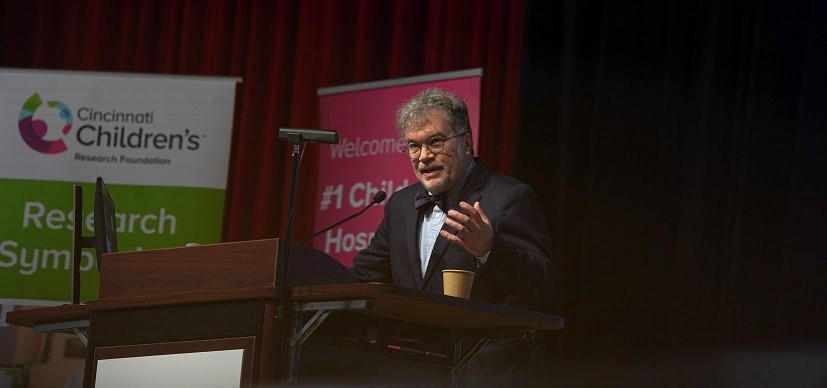Sickle Cell Breakthrough: A Pill to Replace Blood Transfusions
Research By: Russell Ware, MD, PhD
Post Date: June 28, 2019 | Publish Date: Feb. 13, 2016

Imagine replacing the expensive and tedious process of monthly blood transfusions with a simple pill that costs less than $1 a day.
That is the dramatic improvement in care happening now for many children and teens with sickle cell disease, thanks to breakthrough research led by Russell Ware, MD, PhD, and colleagues at Cincinnati Children’s.
Stroke is one of the deadliest complications of sickle cell disease. As many as one in 10 children born with this common genetic condition will suffer at least one stroke before reaching adulthood. Many will become disabled and some do not survive.
The 25-center TWiTCH clinical trial to evaluate hydroxyurea as a stroke prevention therapy was so successful that officials ended the study early.

For years, the medical community has used blood transfusions to battle this risk. The treatment helps, but it requires bringing children to facilities properly staffed and equipped to store and transfuse blood month after month, indefinitely. Meanwhile, for many, the transfusions carry risks of transmitting infections and inevitably lead to iron overload, which requires an expensive medication to correct.
“Unfortunately, this First World solution is not adequate for a disease that actually strikes far more children in the Third World,” Ware says.
Enter hydroxyurea.
CLEAR SUCCESS LEADS TO EARLY END FOR TWiTCH STUDY
Ware served as the national principal investigator for a study launched in 2011 called, “TCD With Transfusions Changing to Hydroxyurea (TWiTCH).” The project sought to compare how well this inexpensive medication prevents stroke compared to traditional blood transfusions.
The drug worked so well that the National Heart, Lung, and Blood Institute (NHLBI) stopped the study in late 2014, over a year earlier than projected, after treating just 83 patients.
“We want to take the lessons learned here and export them to low-resource countries.”
—Russell Ware, MD, PhD
Ware presented these results in December 2015 as a plenary talk at the American Society of Hematology Annual Meeting in Orlando:
- 42 in the transfusion arm and 41 in the hydroxyurea arm completed two years of treatment.
- Average transcranial Doppler (TCD) velocities of intracranial blood flow were similar between both patient groups (143±1.6 cm/sec transfusion vs. 138±1.6 cm/sec hydroxyurea).
- A posthoc analysis suggests that hydroxyurea may be superior at lowering TCD velocities and reducing stroke risk.
“No child should ever suffer a stroke, which is why it was so important for the NHLBI to support the TWiTCH trial,” NHLBI director Gary Gibbons, MD, said when the study stopped. “This critical research finding opens the door to more treatment options for clinicians trying to prevent strokes in children living with sickle cell disease.”
ACTING LOCALLY AND GLOBALLY
At Cincinnati Children’s and other centers in the U.S. and Canada, more children identified by TCD testing as high risk for stroke are now switching from blood transfusions to hydroxyurea as the preferred first-line treatment for stroke prevention.
Meanwhile, experts from Cincinnati Children’s have donated TCD equipment and trained medical teams in the Dominican Republic, Jamaica, and Uganda on how to track stroke risk among children with sickle cell disease. These efforts could serve as models for even wider-scale adoption of this new treatment.
“We want to take the lessons learned here and export them to low-resource countries,” Ware says.
In the U.S., doctors are prescribing hydroxyurea earlier in life for growing numbers of sickle cell patients. Previous research led by Ware and others has demonstrated the drug’s value in managing pain and other symptoms that can occur long before elevated stroke risks emerge.
“With the wider use of hydroxyurea continuing in even younger patients, the need to use it specifically to prevent stroke may become a non-issue in 10 years,” Ware says.
WHAT’S NEXT IN HYDROXYUREA RESEARCH?
Research to evaluate hydroxyurea use in lower-income countries continues. More information could be published in 2017 about how the drug works in populations with high rates of malaria, Ware says.
| Original title: | Hydroxycarbamide versus chronic transfusion for maintenance of transcranial doppler flow velocities in children with sickle cell anaemia-TCD With Transfusions Changing to Hydroxyurea (TWiTCH): a multicentre, open-label, phase 3, non-inferiority trial |
| Published in: | Lancet |
| Publish date: | Feb. 13, 2016 |
Research By







